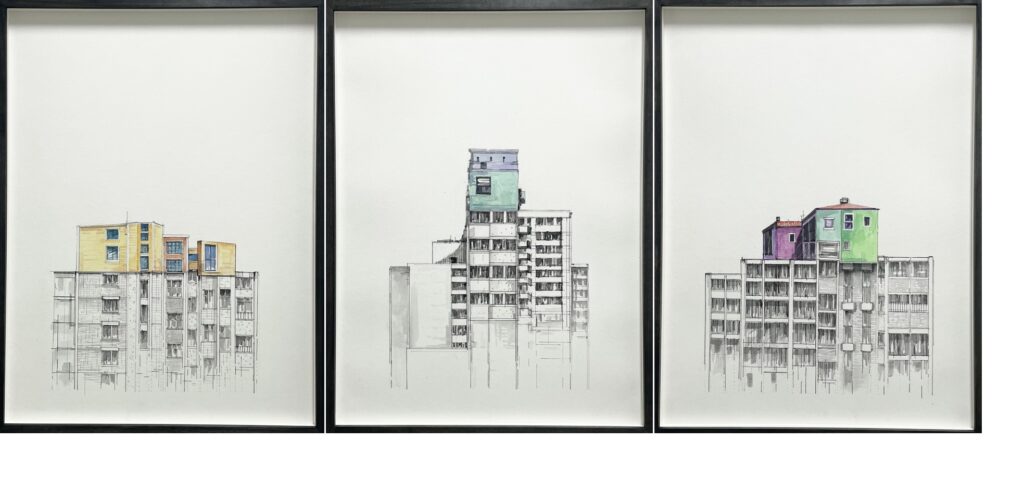alban muja: fragments of walls
exhibition's introductory text by curator jehona morina

Alban Muja, three watercolours on paper from the series Above Everyone, 2022, cm 50×38 (courtesy Charim Galerie, Vienna)
Alban Muja: Fragments of Walls
What does it mean to live in spaces that are neither fully formed nor entirely erased—spaces where necessity writes its own rules, where history lingers as both weight and resource? Alban Muja’s works invite us into these spaces, where structures emerge as monuments to lives shaped by adversity, endurance, and the shadows of unresolved pasts.
Muja’s practice is driven by the evolving dynamics of social, political and economic transformations in his native Kosovo and the wider Balkans. Often engaging with architecture and public spaces, Muja examines how these reflect broader societal narratives, while at times linking them to his own lived experiences. Drawing from the processes that have shaped the region, Muja employs a range of mediums, including video, painting, drawing, and installation, to create works that explore the complexities of societal change. This exhibition brings together two projects by Muja—a two-channel video installation and a series of watercolors on paper. Set against the urban landscapes of Albania and Kosovo, these works reflect the lingering traces of socio-political upheavals that continue to shape everyday life.
In his video work Why Kamza (2021), Muja presents a visual essay that offers a temporal view of Kamza, a town on the outskirts of Albania’s capital, Tirana. Filmed from a moving car, the footage alternates between sunset and sunrise views, capturing rows of retail outlets and roadside developments on both sides of the street. With its seemingly endless panorama of furniture shops, the resulting imagery creates a haunting, ghostly tableau, simultaneously modern and desolate. At first glance, the shops seem benign, yet their sheer number hint at something amiss. The excess of identical or nearly identical businesses raises questions—are these spaces mere facades, or do they reveal something about the hidden economies and structures that pulse beneath the surface? Though local details hint at geographic specificity, the repetitiveness and ubiquity of the scenes obscure easy recognition, creating a broader commentary on the fluidity of urban spaces shaped by economic necessity, and post-socialist transitions.
The watercolor series in Above Everyone (2022/2023) depicts buildings in Kosovo layered with rooftop extensions added atop existing structures, reflecting the necessity-driven adaptations of residents. Often created without permits and in violation of housing codes, in a post-war context, they reflect both resourcefulness and the challenges of navigating resources and institutional constraints. Muja’s watercolors capture this tension with subtlety, neither overtly interrogating systemic flaws nor romanticizing these acts of DYI improvisations. Instead, they offer a nuanced exploration of how individuals reclaim agency in reshaping their environments, even when doing so challenges norms. By highlighting the interplay between rebuilding and regulation, individuality and collective order, the works provide a layered perspective on a society in self-realization and transformation.
In Fragments of Walls, Muja explores the subtle traces of the past that continue to manifest in the material realities of the present. His works invite us to look beyond the visible—to consider how structures, both physical and symbolic, can reflect more than just the practicalities of construction; they suggest histories imbued with an unrelenting search for stability. Prompting us to think not only about the places we live in, but also about the very forces that shape those places—memory, narrative, power structures—ultimately posing a larger question: How do these tensions between past and present shape not just a place but an identity, both personal and collective, that emerge within it?
Jehona Morina